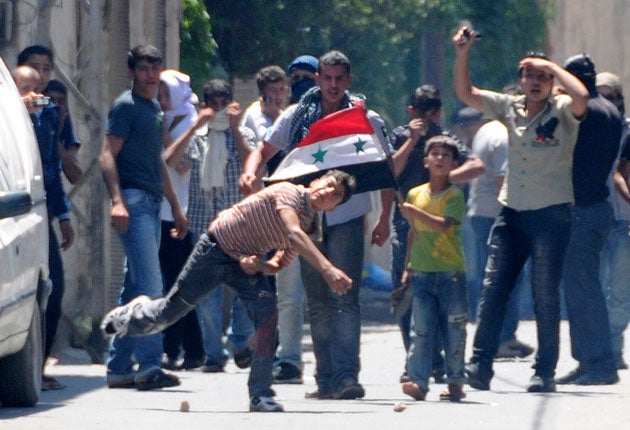Syrian protesters ready for army onslaught as troops mass in Hama

Civilians in Hama, scene of a notorious massacre in 1982, were braced for a military onslaught last night as tanks and troops massed on the outskirts of the ancient Syrian city, days after hundreds of thousands of demonstrators rallied there in a renewed bid to topple President Bashar al-Assad.
Human rights activists said security personnel in the suburbs had been seen making sweeping arrests hours before the expected assault. Militias loyal to the government were also spotted in a number of neighbourhoods.
A doctor in Hama, who asked not to be identified, told The Independent that the atmosphere throughout Hama was "tense", adding: "I'm worried. I've heard there have been lots of arrests and I saw on the news they are sending troops here." Video footage uploaded on to YouTube showed dozens of tanks and armoured personnel carriers being driven down a motorway, some with soldiers sitting on top, waving flags. The film, shot from a passing car and posted online at the weekend, claimed the convoy was heading towards Hama. It was not possible to verify the footage.
A medical student from Homs, a city in central Syria, said a friend from Hama was arrested in a dawn raid yesterday. "His family said the security forces came to their house in the morning ... They took him away in pyjamas."
The witness, who did not want to be named, said his friend attended the demonstration in Hama on Friday – one of the biggest ever seen in the city. Before the demonstration, in which protesters chanted for their President to leave office, the Baathist regime had reportedly withdrawn most of its military and security personnel.
The decision made it much easier for protesters to congregate around the clock tower in central Hama's Al-Assi Square. Some estimates put the number of protesters at more than 200,000 – a huge figure for an uprising which analysts say has yet to reach the tipping point achieved in similar rallies across the Arab world. In an apparent response to the Hama protest, state television announced the sacking of the city's governor at the weekend. No reason was given for the dismissal. Andrew Tabler, a Syria expert from the Washington Institute for Near-East Policy, said the regime's moves were "a sign of the confusion" about how to deal with the escalating protests and the government's military overstretch.
Last month, at least 60 civilians were killed in a day after demonstrations in Hama. It was one of the bloodiest episodes in the country's 14-week insurrection, and yesterday's troop deployments raised fears that the Baathist regime intended to repeat its uncompromising tactics in a bid to make an example of the city.
"The authorities seem to have opted for a military solution to subdue the city," Rami Abdel-Rahman, president of the Syrian Observatory for Human Rights, told Reuters news agency.
In 1982, Hama was the scene of a brutal government operation against the Muslim Brotherhood. In a bid to suppress the Islamist organisation, which was waging an armed insurgency, the government launched an assault which killed between 15,000 to 30,000 civilians. The shadow of Hama has acted as a warning against political agitation ever since.
Housam Mohammad, a Syrian journalist based in the UK, said: "Hama has a horrible legacy which has haunted Syrians until now. It was used as a lesson to oppress the Syrian people."
Human rights groups say that about 1,400 civilians have been killed since mass rallies against the 41-year regime of the Assad family began in mid-March. The US and the European Union have imposed sanctions on President al-Assad and his inner circle.
Subscribe to Independent Premium to bookmark this article
Want to bookmark your favourite articles and stories to read or reference later? Start your Independent Premium subscription today.

Join our commenting forum
Join thought-provoking conversations, follow other Independent readers and see their replies